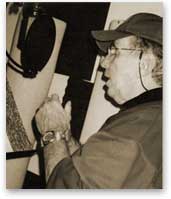Finding a Conversational Voice in Video Tutorials

A few weeks ago I tweeted about an interesting voice over site, and my friend Kevin, who runs the Short Cummings Audio podcast, replied that a local voice-over guru in Salt Lake, Scott Shurian, gives workshops on voice.
I wanted to improve my voice-based video tutorials, podcasts, training, and presentations, so I thought I'd check it out. Scott is a nice guy and was willing to trade a blog install/design for the cost of the workshop (which lasts several weeks).
A voice over is a voice narration from a performer whom you can't see, who reads a script in an engaging way according to the context of the script. For example, many commercials employ voice overs from professionals.
The difference between voice-over performers and announcers, Scott says, is that voice-over performers get outside of themselves, whereas announcers merely read a script.
To get outside of yourself, Scott said you must imagine who you are, who you're talking to, and where you are. When you can imagine this context, you read the script as a performance. It's the performance that engages listeners.
Hmmm, I thought, this no doubt applies to acting, but what about video tutorials, where I'm simply me talking to users? Scott encouraged me to imagine myself sitting in a café talking to a friend in a conversational way. He had me read a sample script imagining that I was having a natural conversation with someone I knew, in the context of a café.
Wow, you wouldn't believe what a difference it makes when you take your mind off the idea that you're merely reading.
As practice, Scott recommends reading a poem out lout every day. And of course not just reading the poem, but imagining a context for it –- imagining in your mind who you are, who you're talking to, and where you're located.
He also recommends reading obituaries, performing as if you knew the one who died, and as if you were familiar with all of his or her accomplishments. I haven't tried either of these activities yet, but I'm jazzed about the conversational context. I'm convinced that it has to be one of the key features of a good video tutorial.
Additional Resources
About Tom Johnson

I'm an API technical writer based in the Seattle area. On this blog, I write about topics related to technical writing and communication — such as software documentation, API documentation, AI, information architecture, content strategy, writing processes, plain language, tech comm careers, and more. Check out my API documentation course if you're looking for more info about documenting APIs. Or see my posts on AI and AI course section for more on the latest in AI and tech comm.
If you're a technical writer and want to keep on top of the latest trends in the tech comm, be sure to subscribe to email updates below. You can also learn more about me or contact me. Finally, note that the opinions I express on my blog are my own points of view, not that of my employer.
